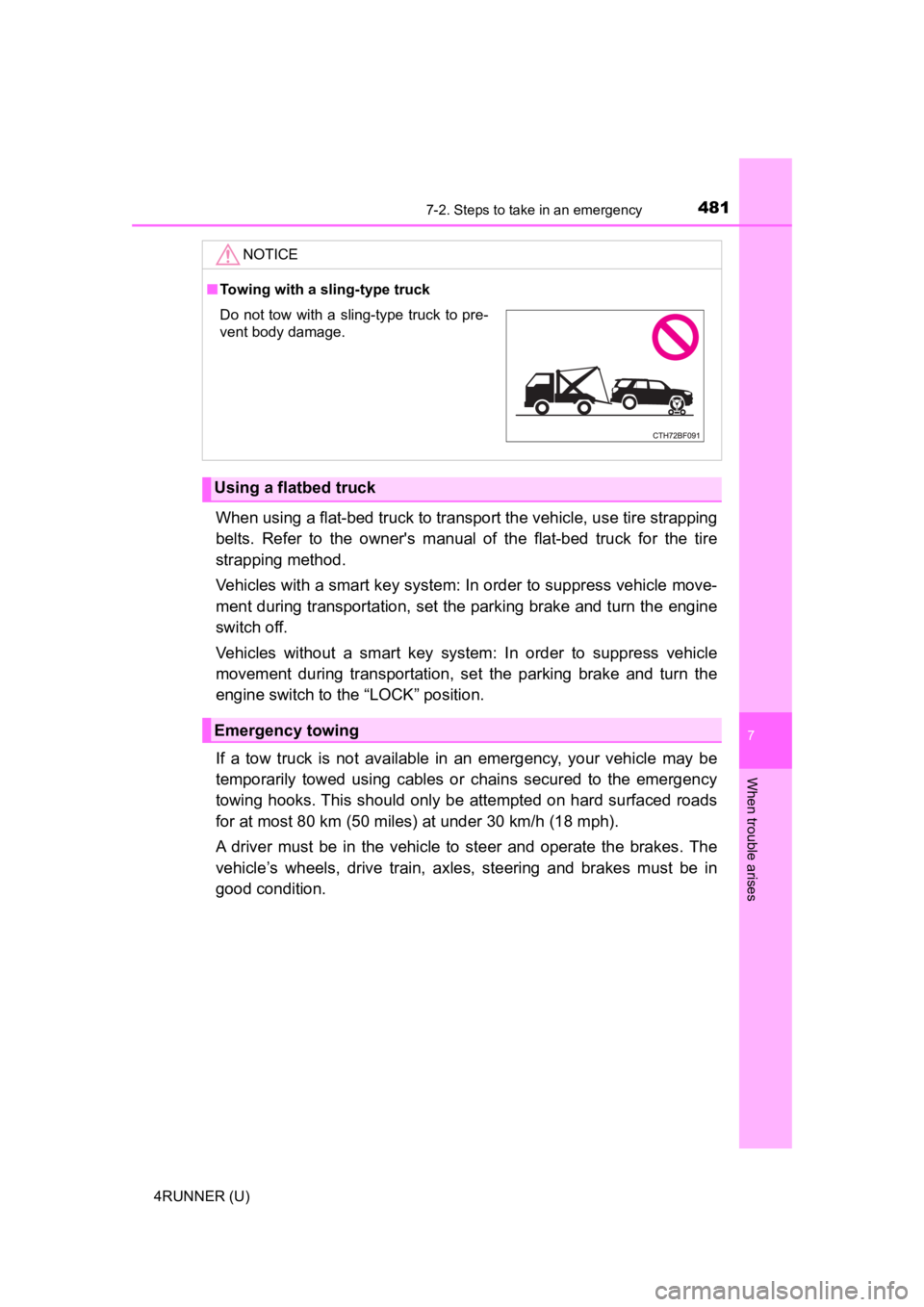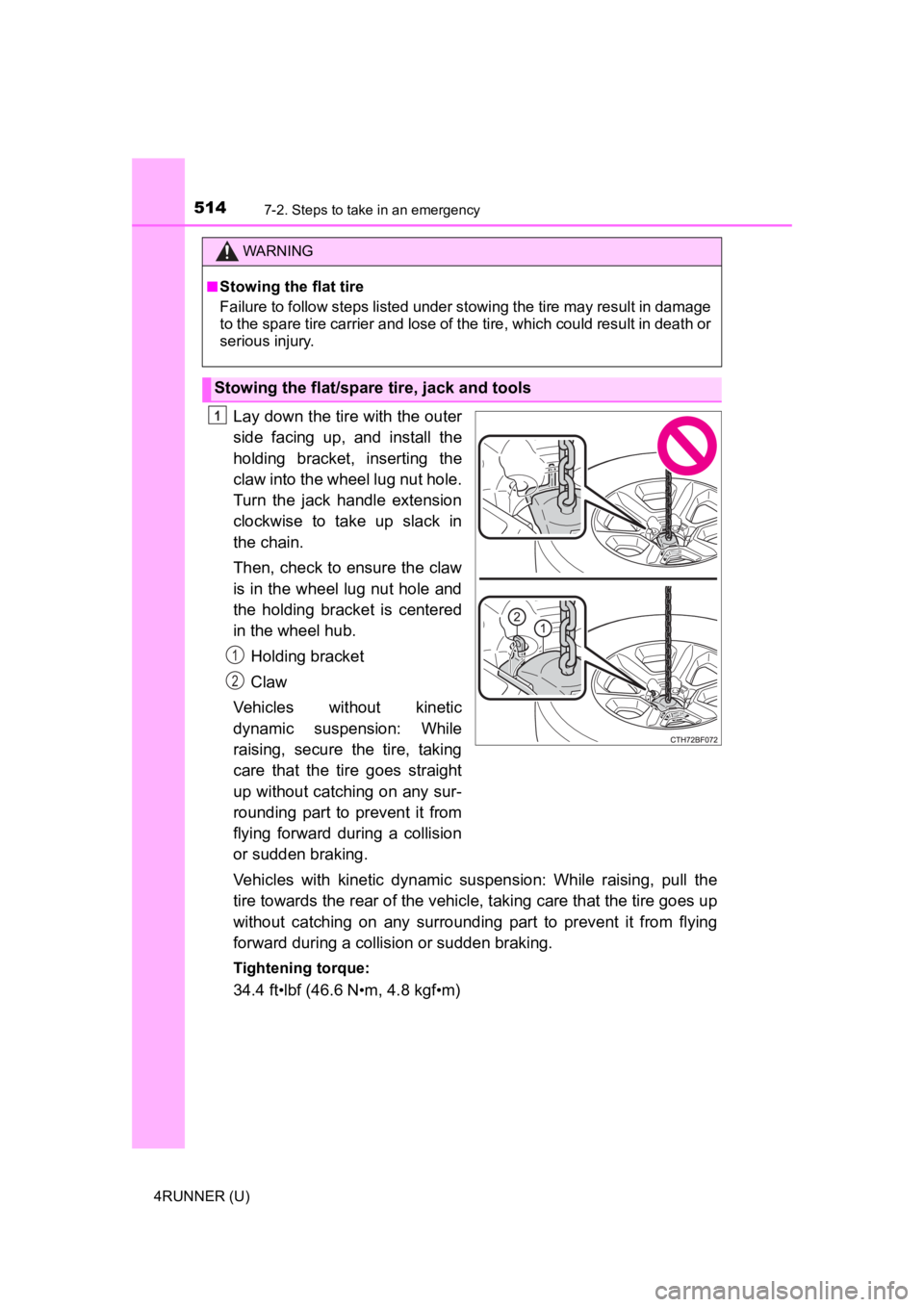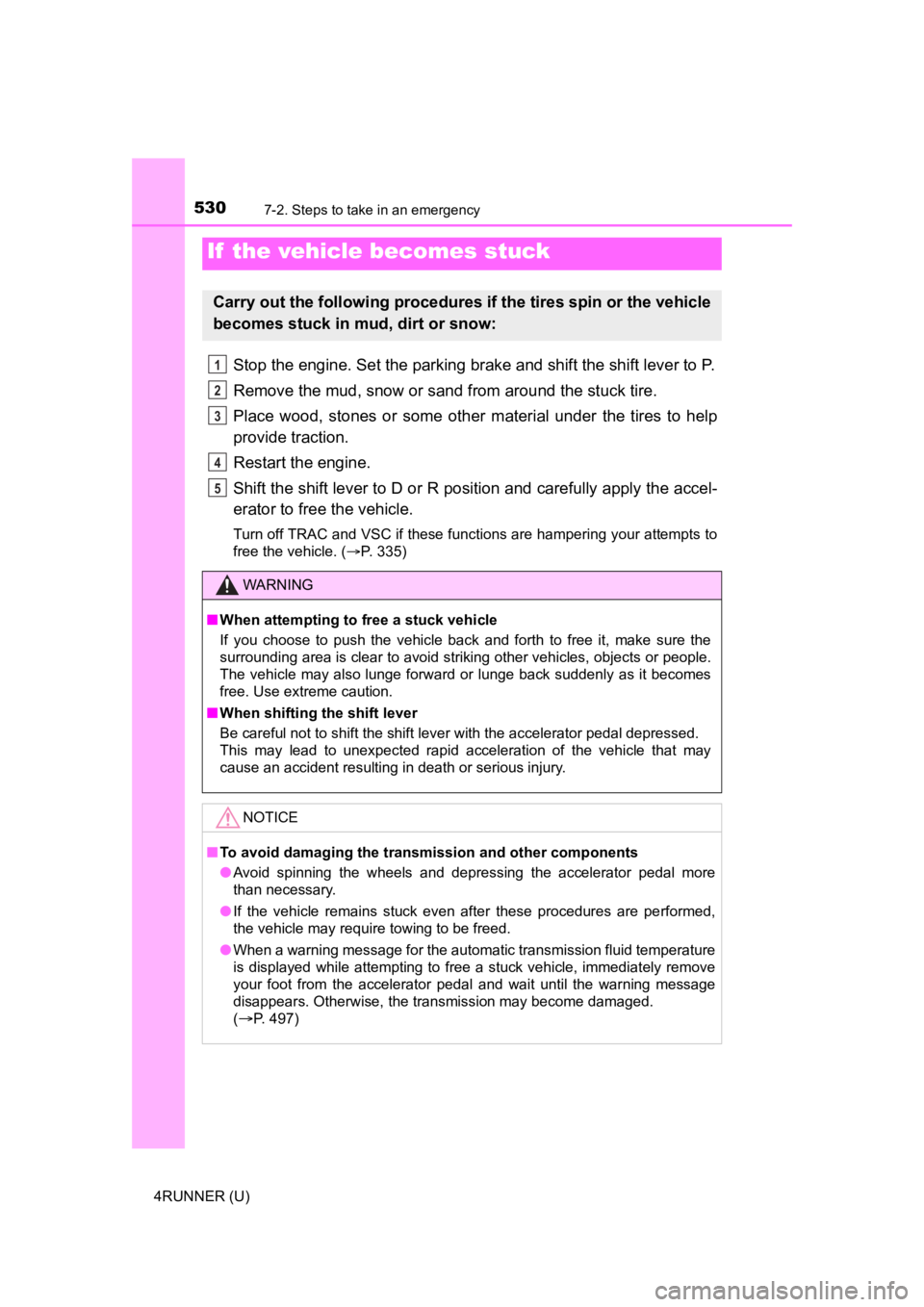Page 481 of 616

4817-2. Steps to take in an emergency
7
When trouble arises
4RUNNER (U)
When using a flat-bed truck to transport the vehicle, use tire strapping
belts. Refer to the owner's manual of the flat-bed truck for the tire
strapping method.
Vehicles with a smart key system: In order to suppress vehicle move-
ment during transportation, set the parking brake and turn the engine
switch off.
Vehicles without a smart key system: In order to suppress vehic le
movement during transportation, set the parking brake and turn the
engine switch to the “LOCK” position.
If a tow truck is not available in an emergency, your vehicle m ay be
temporarily towed using cables or chains secured to the emergen cy
towing hooks. This should only be attempted on hard surfaced roads
for at most 80 km (50 miles) at under 30 km/h (18 mph).
A driver must be in the vehicle to steer and operate the brakes . The
vehicle’s wheels, drive train, axles, steering and brakes must be in
good condition.
NOTICE
■ Towing with a sling-type truck
Using a flatbed truck
Emergency towing
Do not tow with a sling-type truck to pre-
vent body damage.
Page 482 of 616
4827-2. Steps to take in an emergency
4RUNNER (U)
Vehicles with front covers only:
Before using the front emer-
gency towing eyelet(s), remove
the cover(s).Removing the clips
Installing the clips
Securely attach cables or
chains to the towing hook.
Take care not to damage the vehi-
cle body.
Enter the vehicle being towed and start the engine.
Vehicles with a smart key system: If the engine does not start, turn the
engine switch to ON.
Vehicles without a smart key system: If the engine does not sta rt, turn the
engine switch to the “ON” position.
Emergency towing procedure
1
1
2
2
3
Page 483 of 616
4837-2. Steps to take in an emergency
7
When trouble arises
4RUNNER (U)
Part-time 4WD models:
Ty p e A
Shift the front-wheel drive control lever to H2.
Ty p e B
Push the “UNLOCK” button and turn the front-wheel drive control
switch to H2.
Full-time 4WD models: Push the “UNLOCK” button and turn the
four-wheel drive control switch to H4F. (The center differentia l is
unlocked.)
Shift the shift lever to N and release the parking brake.
When the shift lever cannot be shifted: P. 2 1 9
■While towing
If the engine is not running, the power assist for the brakes a nd steering will
not function, making steering and braking more difficult.
4
5
Page 514 of 616

5147-2. Steps to take in an emergency
4RUNNER (U)
Lay down the tire with the outer
side facing up, and install the
holding bracket, inserting the
claw into the wheel lug nut hole.
Turn the jack handle extension
clockwise to take up slack in
the chain.
Then, check to ensure the claw
is in the wheel lug nut hole and
the holding bracket is centered
in the wheel hub.
Holding bracket
Claw
Vehicles without kinetic
dynamic suspension: While
raising, secure the tire, taking
care that the tire goes straight
up without catching on any sur-
rounding part to prevent it from
flying forward during a collision
or sudden braking.
Vehicles with kinetic dynamic su spension: While raising, pull the
tire towards the rear of the vehi cle, taking care that the tire goes up
without catching on any surrounding part to prevent it from flying
forward during a collision or sudden braking.
Tightening torque:
34.4 ft•lbf (46.6 N•m, 4.8 kgf•m)
WARNING
■Stowing the flat tire
Failure to follow steps listed under stowing the tire may result in damage
to the spare tire carrier and lose of the tire, which could res ult in death or
serious injury.
Stowing the flat/spare tire, jack and tools
1
1
2
Page 516 of 616

5167-2. Steps to take in an emergency
4RUNNER (U)
NOTICE
■Do not drive the vehicle with a flat tire
Do not continue driving with a flat tire.
Driving even a short distance with a flat tire can damage the tire and the
wheel beyond repair.
■When stowing the flat tire
Ensure that there is no object c aught between the tire and the vehicle
underbody.
■When replacing the tires
●When removing or fitting the wheels, tires or the tire pressure warning
valve and transmitter, contact your Toyota dealer as the tire p ressure
warning valve and transmitter may be damaged if not handled cor -
rectly.
●Replace the grommets for the tire pressure warning valves and trans-
mitters as well.
■To avoid damage to the tire pressure warning valves and transmi t-
ters
When a tire is repaired with liquid sealants, the tire pressure warning valve and transmitter may not operate properly. If a liquid sea lant is
used, contact your Toyota dealer or other qualified service shop as soon
as possible. Make sure to replace the tire pressure warning valve and
transmitter when replacing the tire. ( P. 438)
Page 530 of 616

5307-2. Steps to take in an emergency
4RUNNER (U)
Stop the engine. Set the parking brake and shift the shift lever to P.
Remove the mud, snow or sand from around the stuck tire.
Place wood, stones or some other material under the tires to help
provide traction.
Restart the engine.
Shift the shift lever to D or R position and carefully apply th e accel-
erator to free the vehicle.
Turn off TRAC and VSC if these functions are hampering your attempts to
free the vehicle. ( P. 335)
If the vehicle becomes stuck
Carry out the following procedures if the tires spin or the vehicle
becomes stuck in mud, dirt or snow:
WARNING
■When attempting to f ree a stuck vehicle
If you choose to push the vehicle back and forth to free it, make sure the
surrounding area is clear to avoid striking other vehicles, obj ects or people.
The vehicle may also lunge forward or lunge back suddenly as it becomes
free. Use extreme caution.
■ When shifting the shift lever
Be careful not to shift the shift lever with the accelerator pedal depressed.
This may lead to unexpected rapid acceleration of the vehicle t hat may
cause an accident resulting in death or serious injury.
NOTICE
■ To avoid damaging the transmission and other components
● Avoid spinning the wheels and depressing the accelerator pedal more
than necessary.
● If the vehicle remains stuck even after these procedures are pe rformed,
the vehicle may require towing to be freed.
● When a warning message for the automatic transmission fluid tem perature
is displayed while attempting to free a stuck vehicle, immediat ely remove
your foot from the accelerator pedal and wait until the warning message
disappears. Otherwise, the transmission may become damaged.
(
P. 497)
1
2
3
4
5
Page 602 of 616

602Alphabetical index
4RUNNER (U)
Tires .......................................... 435Chains................................... 344
Checking ............................... 435
If you have a flat tire ............. 502
Inflation pressure .................. 540
Information ............................ 545
Replacing .............................. 502
Rotating tires......................... 436
Size ....................................... 540
Snow tires ............................. 345
Spare tire .............................. 502
Tire pressure warning
system ......... ....................... 437
Warning light ......................... 490
Tools ......................................... 503
Top tether strap ......................... 68
Total load capacity .................. 189
Towing Dinghy towing ....................... 206
Emergency towing ................ 481
Trailer towing ........................ 190
Toyota Safety Sense P ............ 243 Automatic High Beam ........... 228
Dynamic radar cruise
control................................. 268
LDA (Lane Departure Alert)........ 260
PCS (Pre-Collision System)........ 250 TRAC (Traction Control) ......... 333
Trailer Sway Control ............... 333
Transmission ........................... 216
Trip information ......................... 90
Trip meters ................................. 90
Turn signal lights .................... 221
Replacing light bulbs .... 465, 469
Turn signal lever ................... 221
Wattage ................................ 541
USB port
*
Valet key ................................... 104
Vanity lights ............................. 384 Wattage ................................ 541
Vanity mirrors .......................... 384
Vehicle data recordings .............. 9
Vehicle identification number ................................... 533
Vehicle Stability Control (VSC) ...................................... 333
Ventilators
(seat ventilators) ................... 367
VSC (Vehicle Stability Control) .... 333
U
V